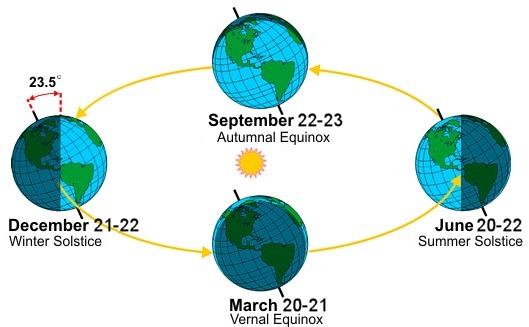What is Autumnal equinox?

Autumnal equinox, two moments in the year when the Sun is exactly above the Equator and day and night are of equal length. There are only two times of the year when the Earth's axis is tilted neither toward nor away from the sun, resulting in a nearly equal amount of daylight and darkness at all latitudes. These events are referred to as Equinoxes.
The equinoxes happen in March (about March 21) and September (about September 23) on these days the Sun is exactly above the Equator. The equator and places near the equator experience nearly 12 hours of the day and 12 hours of the night.
While the September equinox usually occurs on September 22 or 23, it can very rarely fall on September 21 or September 24. This is because of the difference between how the Gregorian calendar defines a year (365 days) and the time it actually takes for Earth to complete its orbit around the Sun (about 365 and 1/4 days). This means that each equinox occurs about 6 hours later than the previous year's Equinox. This eventually moves the date by a day.
why different regions of the Earth experience different measures of sunlight?
- The seasons on Earth change because the planet is slightly tilted on its axis as it travels around the Sun. Earth’s rotational axis makes an angle of 23.5° with the normal and angle of 66.5° with the orbital plane.
- If Earth were not tilted, the Sun would always appear to be directly above the Equator, the amount of light a given location receives would be fixed, and there would be no seasons. There also would be no need to mark equinoxes or solstices.
Solstices:
- The two solstices happen in June (20 or 21) and December (21 or 22). These are the days when the Sun’s path in the sky is the farthest north or south from the Equator.
- In the Northern Hemisphere, the June solstice marks the start of summer, this is when the North Pole is tilted closest to the Sun, and the Sun’s rays are directly overhead at the Tropic of Cancer.
- The summer solstice occurs when the sun is directly over the Tropic of Cancer which is located at 23.5° latitude North and for every place north of the Tropic of Cancer, the sun is at its highest point in the sky and this is the longest day of the year.
- The winter solstice marks the shortest day and longest night of the year, it occurs when the sun is directly over the Tropic of Capricorn, which is located at 23.5° south of the equator.